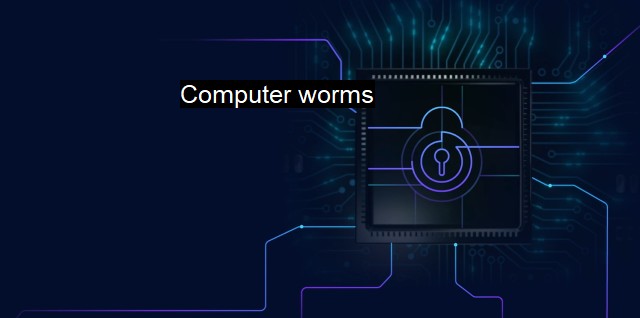What are Computer worms?
Computer Worms: Understanding Tech Intruders and Combating Their Increasing Threat
Computer worms are standalone software programs that, similar to viruses, are capable of replicating themselves to spread to other computers in a network. They are known to be particularly dangerous as they often spread without any human intervention or input. The term ‘Worm’ comes from science fiction, specifically John Brunner’s 1975 novel ‘The Shockwave Rider’.An essential aspect of understanding what makes computer worms so crucial in discussions about cybersecurity is understanding the way they function. While users may need to take some action to allow a computer virus to spread, such as running an infected applications, worms proliferate independently. Upon reaching a new system, this self-contained program executes itself thus causing damage or undesired effects, such as reducing system speed, even to the point of making a system practically unusable, due to the resources it uses to propagate.
Computer worms can cause widespread devastation and are a significant concern in the cybersecurity realm. One primary example of a computer worm’s destructive capability was evident in the case of the 'Conficker’ worm. It infected millions of computers worldwide in 2008 and was designed to exploit weaknesses in Windows OS security. Stuxnet was another notorious worm that was reportedly created by American and Israeli agencies and was used to attack Iran's nuclear facilities. These worms demonstrated just how advanced and targeted worm-type malware could become.
Worms pose severe threats to both personal and corporate cybersecurity infrastructure because of their ability to tunnel deep into systems and exploit security vulnerabilities. They replicate widely, wreaking havoc along the way—slowing network traffic, consuming bandwidth, and even crashing entire systems or networks. The worms can also deliver payloads that commandeer computer resources, turning those systems into 'zombies' or 'bots’. The infected systems then join a botnet (a network of compromised machines) which can carry out further attacks, such as DDoS attacks, spam campaigns, and click fraud, creating a far-reaching impact on cybersecurity.
In terms of defending against worms, understanding how antivirus programs and other cybersecurity measures such as firewalls and intrusion detection/prevention systems operate is crucial. Antivirus software aims to detect, block, and, where possible, remove malware, including worms, from infected systems.
Two primary methods are employed by antivirus software to help achieve this: heuristic analysis and signature detection. Heuristics enable the antivirus to identify suspicious behavior or unknown malware by analyzing the code or executing the program in a safe 'sandbox' environment. Signature detection involves the antivirus program using a library of known malware signatures—a unique set of characteristics for a specific malware—to identify threats.
Relying solely on antivirus solutions can lead to diminishing returns as cyber threats continue to evolve. No single cybersecurity tool can cover all threats; therefore, a multi-layered approach is necessitated—one that includes antivirus programs combined with firewalls, spam filters, secure codes, regular updates, and user awareness and training for efficient cybersecurity hygiene.
Computer worms, couple with the frequency of evolving malware, epitomize the ever-evolving landscape of cybersecurity threats. Due to their sophistication and automatous nature, they necessitate a thorough and robust cybersecurity infrastructure, positioned both at the user endpoints and within network structures. As the digital world becomes increasingly interconnected, understanding and defending against such threats becomes exceptionally paramount to ensuring ongoing data and system security. the cybersecurity landscape is an adversarial battlefield where continuous learning and adapting to fight against threats, like computer worms, is vital for safeguarding our digital ecosystem.

Computer worms FAQs
What are computer worms?
Computer worms are malicious software that spread through computer networks by exploiting vulnerabilities in operating systems and software applications. They replicate themselves and infect other computers on the network without requiring user interaction.How do computer worms differ from viruses?
Computer worms are self-replicating programs that spread by exploiting vulnerabilities in networked computers, whereas viruses require a host program to attach themselves to and they cannot spread in the same way as worms. Worms can also cause more damage to networks and systems as they can rapidly spread and consume network bandwidth.How can I protect my computer from worm attacks?
To protect your computer from worm attacks, you should ensure that your operating system and software applications are up to date with the latest security patches. You should also have a reputable antivirus software program installed and keep it updated. It is also important to be cautious when opening email attachments or clicking on links from unknown sources.What are some examples of well-known computer worms?
Some well-known computer worms include the Morris Worm, launched in 1988, which infected thousands of computers and caused significant disruption to the nascent internet, and the Conficker Worm, which infected millions of computers worldwide in 2008. Other examples include Mydoom, Slammer, and Code Red.| | A | | | B | | | C | | | D | | | E | | | F | | | G | | | H | | | I | | | J | | | K | | | L | | | M | |
| | N | | | O | | | P | | | Q | | | R | | | S | | | T | | | U | | | V | | | W | | | X | | | Y | | | Z | |
| | 1 | | | 2 | | | 3 | | | 4 | | | 7 | | | 8 | | |||||||